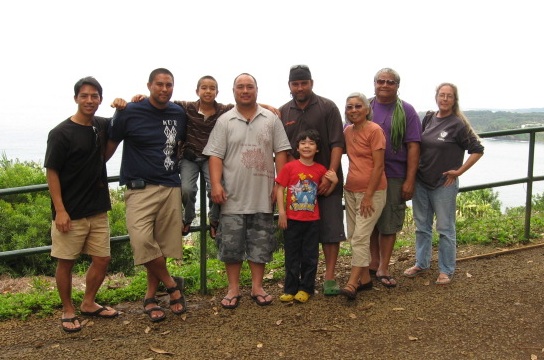‘Ōno kāhi ‘ao lū‘au me ke aloha pū. ‘Olelo No‘eau 2523
A little taro green is delicious when love is present. Or, even the plainest food is ‘ono when there is love.
Mahalo
This website is based on the work of kalo farmers. In 1939, three faculty from the University of Hawaii College of Tropical Agriculture and Human Resources (CTAHR), set out to meet these farmers and document the varieties before they disappeared. Credit goes to CTAHR faculty F. A. I. Bowers, M. Takahashi and Leo. D. Whitney, and to the Hawaiian farmers they interviewed across the Islands.
This site’s kalo photos were taken at botanical collections across Hawaii. On O‘ahu: at Waimea Valley Botanical Garden, Waimanalo Agricultural Station, Kanewai Garden, Hui Kū Maoli Ola Native Hawaiian Plant Specialists, and Kaipo‘i Kelling’s hale. On Maui: at Kahanu Gardens and Maui Nui Botanical Gardens and Penny Levin's lo‘i and māla. On Hawai'i Island: UH CTAHR Agriculture Experiment Station - Puna and Jerry Konanui's māla. On Kaua‘i: at Limahuli Garden. On Moloka‘i: UH CTAHR Agriculture Experiment Station - Alton Arakaki's collection.
Special thanks to Jerry Konanui, Penny Levin, Dale Evans and Kaipo‘i Kelling. Respect goes to Uncle Eddie Ka‘anānā, Kupuna Mary Kawena Pukui, and Coach David Eldredge. As educators, their lessons about Hawaiian culture, our community, science and the environment offer a path to improve our lives here and now. Mahalo to Janice Yap for bringing the mea‘ai of the world to the table.
Thanks and credit goes to these people for their influence and inspiration. It is their work and ideas that motivate:
Kēhaunani Abad, PhD
Michi Atkinson
Aunty Valerie Baldovi
Duffy Chang
Martha Cheng
Father Damien of Moloka‘i
Jonathan & Malia Deenik
Kealoha & Claire Domingo
Jon Duarte Design Group (JDDG)
Laurie Dunn
Dr. Lois Englberger
Meredith Desha-Enos
Dr. Carl Evensen
Phil Giles
Dean Hirahara
John Heckathorn
John 21:15-17, “Feed my lambs.”
Kamehameha Publishing
Elise Karr
Kaipo‘i & Ivy Kelling
Dr. Angela Kay Kepler
Mike Ketover
Brian Kirschenmann
Mark Kostka
Narciso Kostka
William Kostka
Jerry & Gladys Konanui
Theresa Krief
Aunty Ah Jook Ku
Penny Levin
Adelino Lorens
Nikki Love
Mike Maciszewski
Marion Lyman Mersereau, author of Eddie Wen' Go
Randolph Moore
Nainoa Thompson
Dr. Kenneth Otagaki
Office of Hawaiian Affairs
Chef Philippe Padovani
Sarah Parker
Michael Pollan
Scott Radway
William Raynor
Leilei Shih
J.R.R. Tolkien
Ben Trevino
Troop 10 - Kaimuki, Boy Scouts of America
Dr. Nicolai Vavilov
Laurie Walker - Peroff
Kealoha Wong
Trisha Kehaulani Watson
Alia Yap
Janice Yap
Willis Yap
Juanita Kukeauopualani Yap

Road to Hana, 2009. Left to Right: Weston Yap, Duffy Chang, Kala Domingo, Kealoha Domingo, Kaipo‘i Kelling, ‘A‘ali‘i Kelling, Gladys Konanui, Jerry Konanui and Penny Levin.